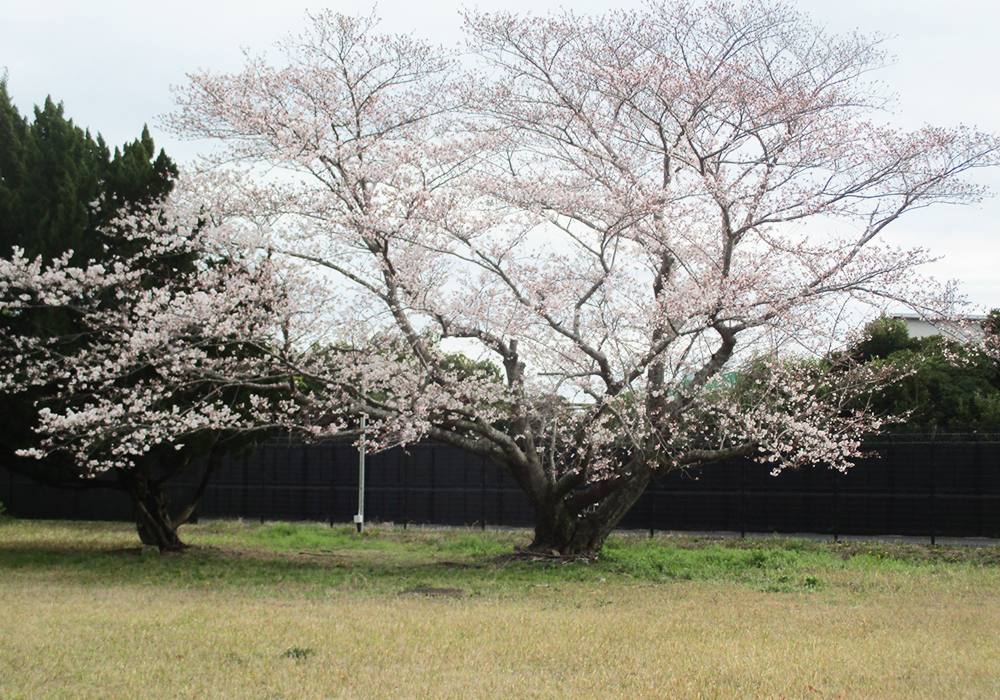EnvironmentalBiodiversity
Disclosures Based on the TNFD Recommendations
Given that the loss of natural resources and biodiversity has a significant impact on society, the Sawai Group has identified reduction of resource use, water use reduction, and conservation of biodiversity as material issues. To address nature-related issues, since fiscal 2024, we have been committed to identifying and organizing the nature-related issues faced by the Group based on the approach provided in the framework of the Taskforce on Nature-related Financial Disclosures (TNFD).*
The Sawai Group supports international policies, including the Kunming-Montreal Global Biodiversity Framework, and Japan's National Biodiversity Strategy, as well as relevant laws, regulations, and policies applicable in the country. We aim to realize a circular economy and conserve biodiversity, disclosing information in line with the TNFD recommendations.
- The Taskforce on Nature-related Financial Disclosures (TNFD), established in 2021, is a global initiative to encourage companies and organizations to analyze and disclose financial information related to natural capital and biodiversity.
Governance
The Sawai Group (hereinafter, the “Group”) recognizes that addressing environmental issues is both one of its corporate social responsibilities (CSR) and one of the important challenges it must tackle to ensure its sustainability and includes biodiversity conservation and contribution to a nature-positive world as its integral components. These duties are executed under the responsibility of the Group Chief Sustainability Officer (GCSO) and under the oversight of the Board of Directors.
The Group has established a Group Sustainability Committee, chaired by the GCSO and composed of representatives from Group companies, which meets four times a year to discuss and deliberate on sustainability matters, including climate change and other nature-related issues. The Committee reports its activities to the Board of Directors and makes decisions concerning matters such as the conservation and restoration of biodiversity and the sustainable use of resources under the direction and oversight of the Board of Directors.
This Committee has a Global Environment Team, which is composed of members from Group companies, as its subordinate organization in charge of promoting specific initiatives and activities to address environmental issues, including biodiversity conservation and restoration. The team reports to the Committee quarterly and constantly engages in its initiatives and improvement activities in line with the Committee’s instructions and advice.
Under the leadership of Global Environment Team members, a working group identifies and assesses nature-related risks and opportunities and implements measures to address them. The results are reported not only to the GCSO but also to the Group Sustainability Committee and the Board of Directors for deliberations so that their post-deliberation instructions and advice are followed for further improvements.
In addition, Sawai Pharmaceutical, the core company of the Group, has also established a Sustainability Committee chaired by the Chief Sustainability Officer, which meets four times a year to discuss and examine sustainability-related matters.
If examining the impacts of and responses to nature-related issues requires us to consider entailed human rights issues, we will manage and oversee the examination process in consideration of the relationships between those two kinds of issues, in accordance with our Group Human Rights Policy. The Group not only complies with all laws and regulations concerning human rights but also, as its Code of Conduct declares, supports and respects the protection of internationally proclaimed human rights, opposes any form of discrimination, and will not be complicit in human rights abuses. We apply this principle to our environmental initiatives and prevent them from causing detriment to any of our stakeholders by ensuring a thorough awareness of the Group Human Rights Policy throughout the Group. For further details, please refer to the Group Human Rights Policy.
Strategy
The Group's business activities rely heavily on benefits brought by biodiversity, which arise from the interconnectedness of diverse life forms on Earth. We also recognize that our continuous operations impose burdens on nature, and we consider it vital to reduce these burdens and promote nature-positive initiatives. In light of this, the Group regards biodiversity-related challenges as one of its key priorities and is committed to activities aimed at conserving and restoring biodiversity.
In locating the Group's key interfaces with nature and identifying the associated risks and opportunities, we follow the LEAP approach,* an assessment approach recommended by the Taskforce on Nature-related Financial Disclosures (TNFD), thereby identifying and evaluating the dependencies and impacts of our business activities on nature and assessing the associated risks and opportunities.
- An integrated assessment approach to nature-related issues that involves four phases: Locate the organization’s interface with nature; Evaluate its dependencies and impacts on nature; Assess its nature-related risks and opportunities; and Prepare to respond to, and report on, material nature-related issues
In fiscal 2024, we underwent an analysis and assessment process through the LEAP approach based on the premises shown in the table below in accordance with the general requirements for disclosure set by the TNFD.
TNFD general requirements for disclosure
| 1. Application of materiality |
|---|
| Adopting the double materiality approach, we evaluated the impact of our business activities on natural capital and the impact of natural capital on our business activities. |
| 2. Scope of disclosures |
| We identified the Group’s dependencies and impacts on nature in its business activities, including pharmaceutical manufacturing, research, and sales, as well as the raw material procurement (upstream) stage and disposal (downstream) stage of pharmaceutical manufacturing, thereby locating its key interfaces with nature, based on which we examined the Group’s risks and opportunities. |
| 3. Location of nature-related issues |
| From among the Group's operational sites, as well as the upstream supplier bases that we judged to be important in consideration of their business or interfaces with nature, we identified sensitive locations from the perspectives of the importance of biodiversity, water stress, and the integrity of ecosystems. |
| 4. Integration with other sustainability-related disclosures |
| Although this disclosure is in line with the TNFD framework, we recognize that climate change and natural capital have impacts on each other, and, in our governance system and risk management process, we evaluate those impacts as environment-related issues in an integrated manner. In the future, we will also consider integrating TCFD disclosures with TNFD disclosures and evaluating their mutual relationships. |
| 5. The time horizons considered |
| In line with the time horizons of the Group's business plans, we defined the period up to three years as the short term, that of four to nine years as the medium term, and that of 10 years or more as the long term, according to which we conducted an analysis based on the status of our business as of 2024. |
| 6. Engagement with Indigenous Peoples, Local Communities and affected stakeholders |
|
The Group not only complies with all laws and regulations related to human rights but also, as its Code of Conduct declares, supports and respects the protection of internationally proclaimed human rights, opposes any form of discrimination, and will not be complicit in human rights abuses. Details: Group Human Rights Policy (PDF: 409KB) , Human rights initiatives |
Furthermore, in conducting this analysis, we utilize various external tools to assess and evaluate the situation, as shown in the table below. These tools generate representative values for the industry and region for reference use.
External Referential Information Tools
| Name | Overview | Purpose of our use for analysis |
|---|---|---|
|
ENCORE (Exploring Natural Capital Opportunities, Risks and Exposure) |
A tool jointly developed by the Natural Capital Finance Alliance (NCFA) and the United Nations Environment Programme World Conservation Monitoring Centre (UNEP-WCMC) to help understand the dependencies and impacts of economic activities on nature | Used to screen the relationship of dependencies and impacts between our business activities and nature |
|
IBAT (Integrated Biodiversity Assessment Tool) |
A tool that provides data on biodiversity, including Key Biodiversity Areas around the world, developed through four-party collaboration between BirdLife International, the United Nations Environment Programme World Conservation Monitoring Centre (WCMC), the International Union for Conservation of Nature (IUCN), and Conservation International | Used to check whether each of our operational sites is located in a Key Biodiversity Area (KBA)* or designated protected area |
| Global Forest Watch | A tool developed by the World Resources Institute to visualize nature-related data on forests, including forest change and biodiversity | Used to check whether each of our operational sites is located in or close to a KBA or designated protected area |
| GLOBIO Model | A model for quantifying the impacts of human activities on biodiversity and ecosystems developed by the Netherlands Environmental Assessment Agency (PBL) | Used to assess the integrity of the ecosystem of the area in which each of our operational sites is located |
| Aqueduet | A water risk assessment tool developed by the World Resources Institute (WRI) | Used to assess water stress in the area in which each of our operational sites is located |
| WWF Biodiversity Risk Filter | An online tool developed by the World Wildlife Fund (WWF) that enables companies to assess and be informed of biodiversity risks according to their locations of operation and types of business | Used to quantify physical and reputational risks related to biodiversity at each of our operational sites (including landslide risks, on which we used assessment data for our overseas sites only) |
| Hazard Map | A tool provided by the Japanese Ministry of Land, Infrastructure, Transport and Tourism that maps flood, landslide, storm surge, and tsunami risks | Used to check whether each of our operational sites in Japan faces a high risk of flooding, landslides, or other kinds of sediment disasters |
- Key Biodiversity Area (KBA): An area of high importance in biodiversity conservation
- We used the WWF Biodiversity Risk Filter in February 2025, ENCORE in November 2024, and the other tools in December 2024.
Identifying our dependencies and impacts on nature
We use ENCORE, an external tool, to identify and screen the Group’s dependencies and impacts on nature in its pharmaceutical manufacturing and sales operations, as well as in both the raw material procurement (upstream) and the disposal (downstream) processes within the supply chain. Furthermore, while using the ENCORE assessment logic as a basis, we re-evaluate the qualitative degree of our dependencies and impacts on nature based on the ENCORE assessment results while taking into account the actual statuses of the Group’s pharmaceutical manufacturing and sales activities and its supplier portfolio. The evaluation results are as shown in the heatmap below.
Dependency and Impact Heatmap (PDF: 343KB)
The ENCORE assessment indicates that, from the perspective of direct relevance to the Group, the pharmaceutical manufacturing process is closely related to water resources due to the risk of pollutant discharge from it and its need for clean water resources. Indeed, within the Group's pharmaceutical manufacturing process, we strive to monitor the water withdrawal and discharge and to appropriately manage substances that could cause water or air pollution, recognizing likely impacts of our water withdrawal and pollutant discharge on nature. Also, since pharmaceutical manufacturing requires raw materials and packaging materials derived from plants, animals, and petroleum, we depend on natural resources themselves and on the ecosystem services, especially the natural regulation of climate and environmental conditions for resource production. Based on the ENCORE analysis results and the Sawai Group's actual condition, among our relationships with nature, we consider the relationships with these kinds of resources to be of particular significance in our examination of nature-related issues.
Furthermore, the ENCORE assessment suggests that the supply chain can have massive impacts on nature through the use of natural resources, such as land and water, the discharge of pollutants into soil, waters, and air, as well as waste, in the process of cultivating vegetal raw materials. The assessment also shows that the cultivation of plants depends heavily on ecosystem services, especially that of supporting the climate system and water circulation systems.
Additionally, the assessment strongly suggests that the manufacturing process of not only petroleum-derived raw materials and packaging materials but also plastic materials and active pharmaceutical ingredients has a particularly close relationship with water resources, thereby indicating a deep connection between water resources and our entire value chain.
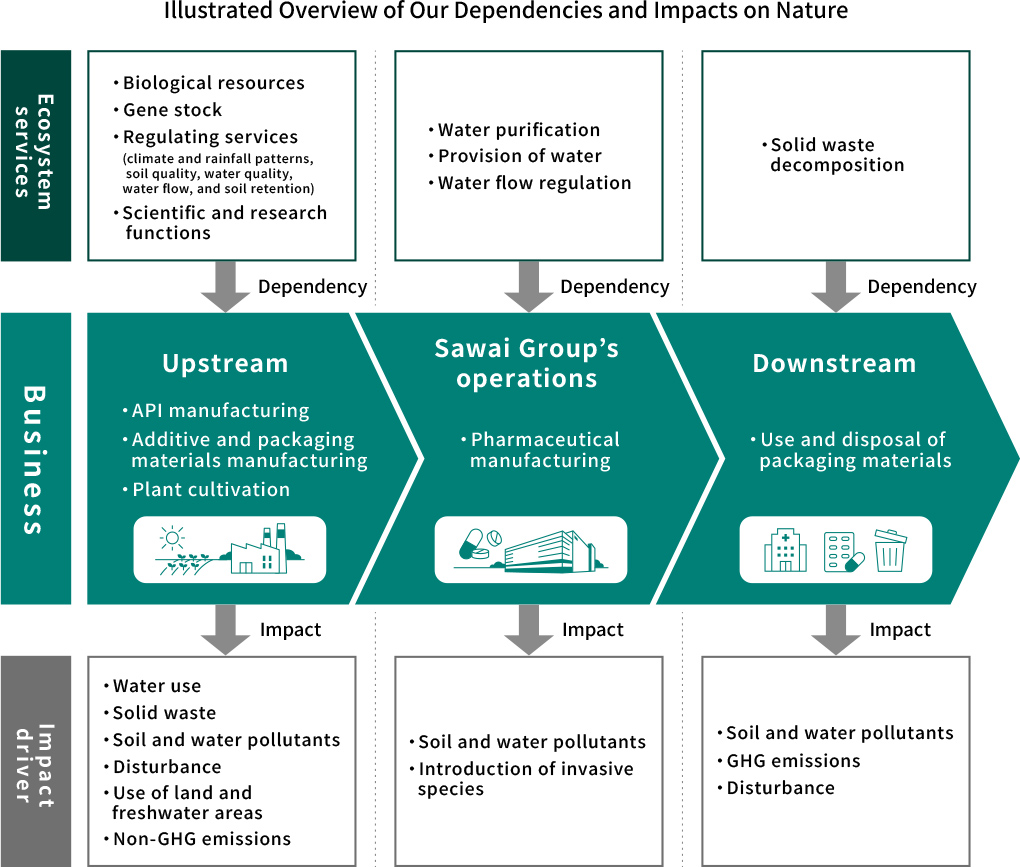
Identification of sensitive locations
The TNFD recommends identifying two kinds of priority locations whose natural environment is of particular concern to the organization: sensitive locations, which are important for biodiversity, and material locations, where the organization has identified material nature-related risks and impacts.
Following this recommendation, we have surveyed sensitive locations along the Group’s pharmaceutical manufacturing value chain and obtained the following survey results.
Sensitive Location Survey Results
| Criterion for sensitive locations | 42 Sawai Group operational sites in Japan |
57 sites of upstream suppliers From the two perspectives of the strength of their connection with nature and their importance in the Group’s business, we selected cultivation sites for plants directly procured by the Group and the operational sites of suppliers manufacturing raw materials for the Group’s key products to be surveyed. |
|---|---|---|
| Importance of biodiversity |
|
|
| Ecosystem integrity | All sites are located in areas of low ecosystem integrity. | All sites are located in areas of low ecosystem integrity. |
| Water stress | All sites are located in areas with low water stress. | One supplier factory in Europe is located in an area with high water stress. |
Among the Sawai Group-owned sites, the survey has located one branch office in Sendai within a wildlife protection area and two other branch offices in Tokyo and Fukuoka, as well as a branch office and sales office housed in the same building in Osaka, close to a wildlife protection area or a KBA.* Serving primarily as sites for office functions such as sales and product management, these locations are negligibly related to activities involving the use of major natural resources other than supply water and sewage services or the discharge of environmental pollutants, suggesting that the degree of their dependencies and impacts on nature is lower than those of manufacturing sites. Also, the survey has found that none of the Group's pharmaceutical manufacturing sites constitute sensitive locations.
- Key Biodiversity Area (KBA): An area of high importance in biodiversity conservation
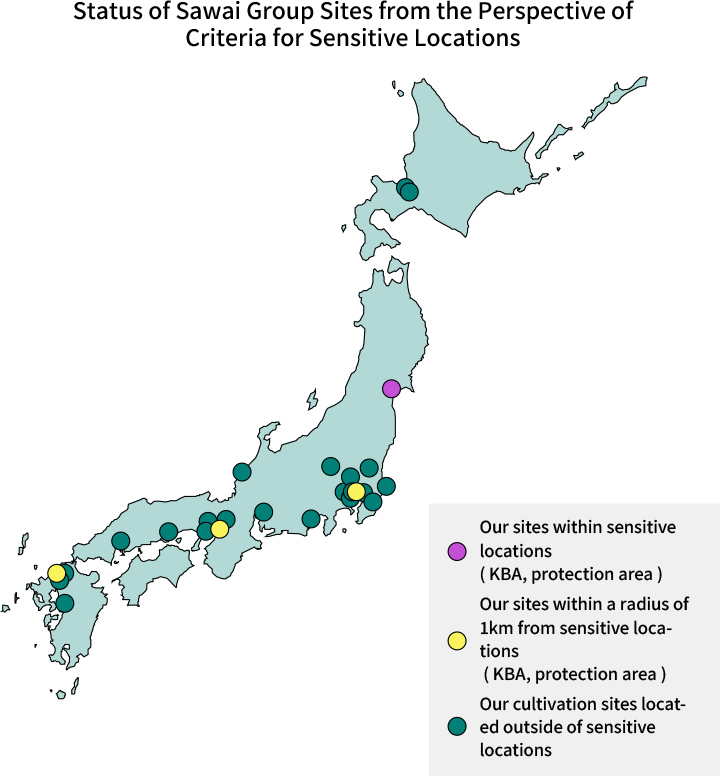
Meanwhile, along our value chain, the survey has located several plant cultivation sites for our direct sourcing within or close to protected areas or KBAs and some Japanese suppliers’ manufacturing sites for key raw materials of our domestic products near protected areas, as well as some overseas suppliers’ manufacturing sites in areas with high water stress.
Identification of risks and opportunities
Recognizing that nature-related risks and opportunities arise from our relationship of dependencies and impacts with nature, we identify material issues from the two-way perspectives of both the risks and opportunities provided to the Group and those provided by the Group's business activities to the environment and society. We have identified risks using the TNFD Nature-related Risk and Opportunity Registers and sector guidance provided by the TNFD. Through a scenario analysis approach, we assess the magnitude of likely impacts of our value chain operations and expected financial impacts on the Group.
Scenario-based risk and opportunity assessment
We employ a scenario analysis approach to evaluate and organize our risks and opportunities, thereby assessing their importance. The TNFD’s guidance on scenario analysis recommends a 2×2 critical uncertainties matrix, which is divided by two axes, one indicating transition risks and the other indicating physical risks, into four quadrants, in each of which is a future scenario. In creating scenarios, following a recommendation given in the guidance, we used two indicators for the level of uncertainties: the level of ecosystem service degradation and the level of alignment of market and non-market driving forces. We then placed various elements along the two axes in consideration of the Group's business condition and used the results to consider what would occur in each of the four scenarios created in the relationship between the two axes.
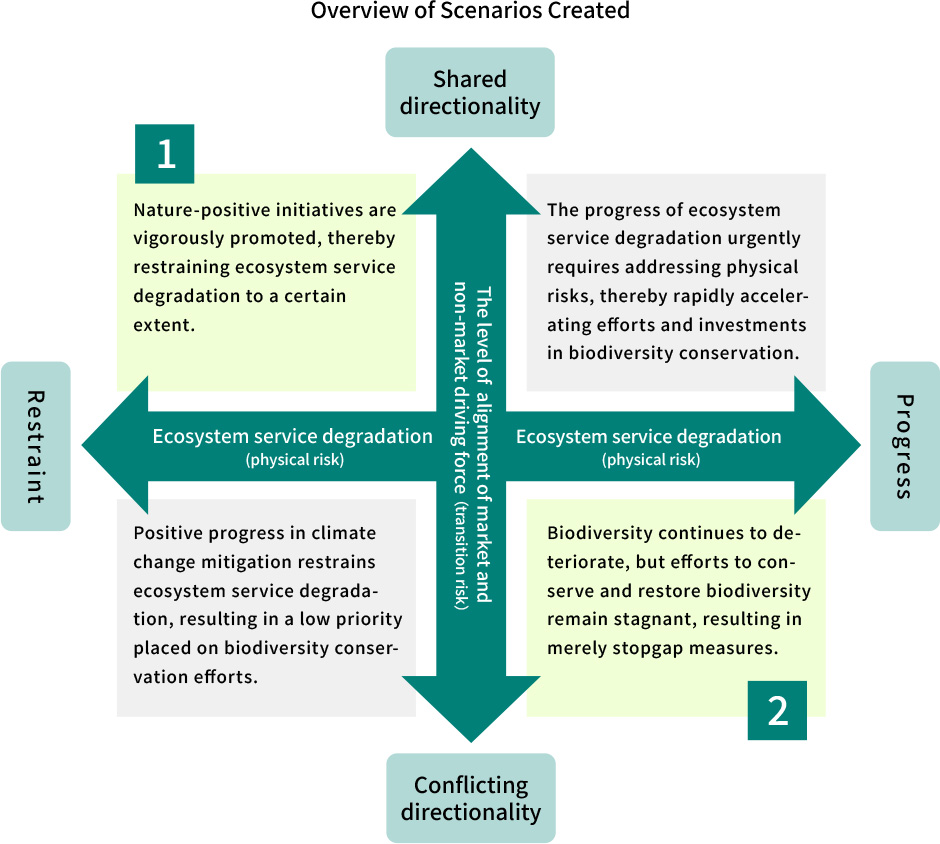
Given that the Sawai Group currently suffers no significant losses on its business due to the deterioration of the natural environment, it is thought that ecosystem service deterioration is not worsening but restrained. Meanwhile, we recognize that the level of alignment of market and non-market driving forces is relatively low due to still low environmental awareness among consumers of pharmaceuticals, despite ongoing environmental conservation efforts, such as strategic planning, made in Japan, where the Group operates, and by the governments of municipalities where our operational sites are located, as well as industrial associations. Given these circumstances, our latest scenario analysis has focused particularly on two extreme scenarios: one where nature-positive initiatives are vigorously promoted, thereby restraining ecosystem service deterioration to a certain extent; and another where biodiversity deteriorates more rapidly than expected, coupled with stagnant efforts in biodiversity conservation and restoration. Through an in-depth analysis under these two scenarios, we assess the Group's resilience to the worst cases anticipated for both transition and physical risks.
In the scenario creation process, we examine the frequency (probability) and severity of anticipated risks and opportunities based on the analyses of our dependencies and impacts on nature and findings from the sensitive location survey to identify risks and opportunities reasonably predicted from the examination results as significant issues.
When examining the severity of risks and opportunities, we consider the specific circumstances of both the Group and the regions where it operates while referring to the magnitude of the Group's activities (as represented by its water withdrawal and discharge, waste volume, etc.) and location-specific risk scores provided by the WWF Risk Filter Suite. Similarly, we also qualitatively assess the frequency (probability) of risks and opportunities based on the number of sites where activities related to the risks or opportunities are conducted and the magnitude of the activities, as well as the status of countermeasure implementation while taking into account factors such as the designation of the relevant areas as sensitive locations and biodiversity regulations imposed by the local authorities.
- It is predicted that, in a future world where nature-positive initiatives are so vigorously promoted that ecosystem service deterioration is restrained to a certain extent, our corporate efforts in nature conservation and nature-positive activities will be highly valued by stakeholders. In addition, progress in climate change mitigation will involve the introduction of new regulations, including those on environmental impacts such as water and soil pollution and on the use of petroleum products, with which we will be required to comply in its sourcing and operational processes. Consequently, we will need to make additional capital investment and review the items we source, likely leading to increased costs. Moreover, with heightened environmental awareness, stakeholders will pay greater attention to the management of potential water and soil pollutants generated during the manufacturing process at factory sites and highly value the company’s nature-positive activities. As a result, it is expected that our ongoing efforts in pollutant management, biodiversity conservation in collaboration with the local authorities, and appropriate disclosures will help enhance our corporate value.
- It is predicted that, in a future world where the progress of biodiversity deterioration is coupled with stagnant efforts in biodiversity conservation and restoration, heightened physical risks will destabilize our procurement of biotic resources and increase the likelihood of extreme weather events causing damage to the Group's operational sites, supplier locations, and distribution channels. In such a world, it will be more crucial than today to verify the environments for our suppliers’ resource production, diversify sourcing locations, and promote disaster preparedness initiatives, and we will be required to conduct nature conservation activities as a response to physical risks. Furthermore, it is likely that national and local governments will advance conservation efforts in line with international standards even if stakeholder awareness of environmental issues does not increase. Therefore, it is expected that appropriately disclosing information while monitoring legal regulations and market trends will become more important.
We have qualitatively assessed the significance of risks and opportunities not only for the Group but also for society and the natural environment in consideration of the results of the abovementioned scenario analysis, the assessment of our dependencies and impacts on nature, and the sensitive location survey, as well as data from the WWF Biodiversity Risk Filter, disaster risk surveys using hazard maps, and investigations into area-specific environmental conditions and legal regulations. The identified and assessed risks and opportunities are as shown in the table below.
Nature-related Risks and Opportunities
| Category | Overview | Impact on the Group’s business, strategy and financial planning | Time horizons*1 |
Materiality*2 | The Group's response | ||
|---|---|---|---|---|---|---|---|
| Risks | Transition risks |
Policy | Tightened regulations on the use of petroleum-derived products | Increased costs for procuring petroleum-derived raw materials and plastic materials and for addressing them mainly by reviewing items to be procured and researching shifts to other materials | Medium / Long | Medium |
|
| Tightened regulations on water, soil, and air pollutants | Increased costs for equipment renewal, operations, etc. | Medium / Long | High | ||||
| Technology | Development of technologies for reducing environmental impacts | Intensified competition in technology utilization, leading to delayed responses causing a profit decline | Long | Medium | |||
| Reputation | Increased public interest in the impact of business activities on nature | Decreased reputation and the resulting boycotts and reduced revenue in the event of any adverse impacts on nature or conflict with local communities in our sourcing or operational process | Long | Medium | |||
| Liability | Liability for compensation in the event of any accidental pollutant discharge from an operational site or of any adverse impact of our operations on the surrounding ecosystems being reported by an external organization | Short / Medium | Medium | ||||
| Physical risks | Acute | Intensification of extreme weather events | Damage to facilities at suppliers' or our own operational sites caused by extreme weather events (such as floods or landslides), resulting in reduced profits due to suspended operations, as well as repair costs | Short / Medium / Long | High |
|
|
| Disrupted transport routes affecting the delivery of raw materials and finished products, leading to reduced profits due to production and operational delays, as well as increased response costs | Short / Medium / Long | High | |||||
| Chronic | Ongoing degradation of the ecosystem service of supporting the production of natural capital | Unstable supply of natural capital necessary for business operations, causing price surges and increased costs for procurement and for supplier review | Medium / Long | High | |||
| Chronic soil degradation, water shortages, extreme weather events, etc. caused by the loss of ecosystem services | Chronic fluctuations in crop cultivation conditions hindering stable plant cultivation on the Group-contracted or owned farms, resulting in losses and increased response costs due to disrupted operations | Medium / Long | Low | ||||
| Opportunities | Resource efficiency |
Development of technologies for enhancing resource efficiency | Reduced consumption of resources, including water, energy, and petroleum-derived processed materials, and decreased waste, increasing productivity and profits | Long | Low |
|
|
| Product & services |
Development of technologies for reducing environmental impacts | Increased revenue due to the launch of more environmentally friendly products, including those packaged in recyclable materials or made from alternative raw materials | Medium / Long | High | |||
| Reputation | Increased stakeholder interest in nature-related issues | Growing reputation among investors and suppliers as a result of appropriate disclosures and dialogue with stakeholders | Short / Medium / Long | Medium | |||
- 1 Time horizons: Short term – up to three years; medium term – four to nine years; long term – 10 years or more
- 2 Significance: Qualitatively assessed based on the severity of impact on both the Group and the natural environment and the probability of occurrence
Selection of Priority Locations
In its engagement in researching, developing, testing, manufacturing, and selling pharmaceuticals, the Group pays due consideration to the results of the abovementioned survey and analysis through the LEAP approach and recognizes that nature-related issues may be of high significance for our factory sites. Since we view the handling of pollutants at the manufacturing stage, the procurement of raw materials used in manufacturing, and the efficient use of resources as key factors in terms of both risks and opportunities, we recognize our factory sites as priority locations for our Group although they do not constitute sensitive locations.
In addition, we will place higher priority on our operational sites that constitute or are located near sensitive locations when selecting venues for nature conservation activities.
We also recognize that whether the sites of upstream suppliers constitute or are located near sensitive locations will be one of the criteria for our judgment when we interview or assess them regarding their initiatives for nature conservation and environmental impact reduction in the future.
These analysis results only cover a portion of the Group’s current value chain in its pharmaceutical manufacturing and sales business. Going forward, we will establish and undergo an environmental due diligence process, a procedure for preliminarily assessing the likely environmental impacts and risks of business activities across the entire supply chain, to increase the scope and depth of our LEAP approach analysis with a view to contributing to a nature-positive world.
Initiatives for the Conservation and Restoration of Biodiversity
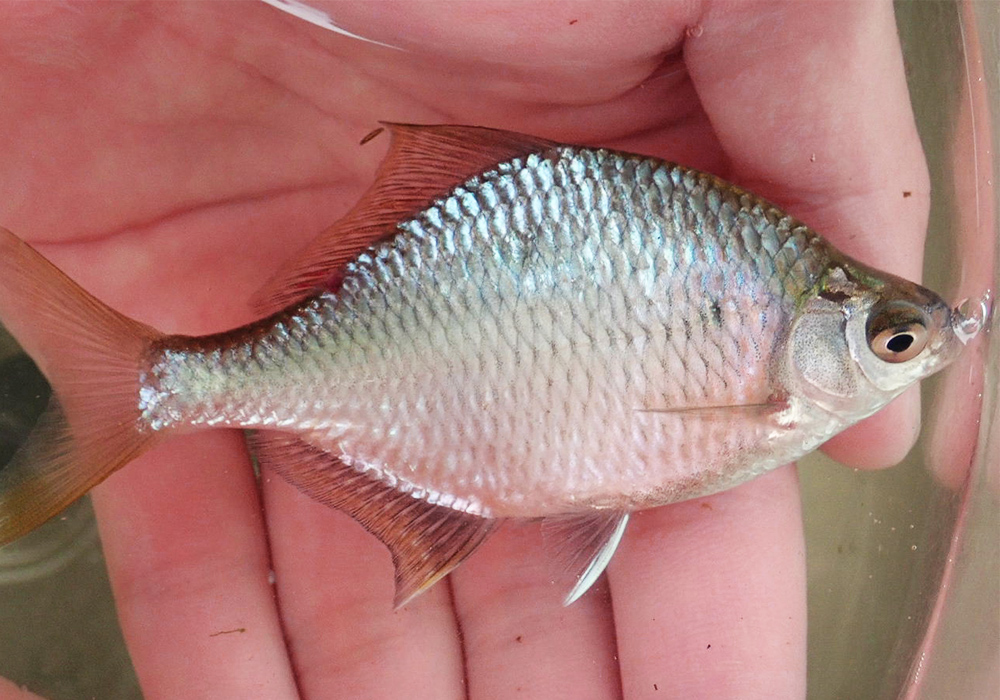
One example of the Group’s initiatives to conserve the water resources that the survey has found to be of particular concern is the initiative to protect the Itasenpara bitterling,* the fish species used as the symbol of the Action Guidelines on Public-Private Partnership for Biodiversity of the Yodo River. At Shirokita Wando (Shirokita Inlet) in Asahi Ward, Osaka City, which is close to the place of the founding of Sawai, we participate in eradicating individuals of foreign fish species and cleaning up the riverbanks.
- Itasenpara: a kind of tanago (Japanese bitterling) designated as a Natural Monument by the Japanese government and classified as an endangered species.
Another example is from Sawai Pharmaceutical’s Kanto Factory, designated as a priority location, where we maintain a favorable habitat for the local wildlife by not only appropriately treating and managing wastewater in compliance with legal requirements but also constructing and maintaining a reservoir that also serves the purpose of flood control.
For appropriate hazardous substance management, we are promoting efforts to develop technologies for reducing risks associated with the discharge of hazardous substances contained in our products. A representative example is the establishment of a new formulation development method with a lower risk of generating nitrosamine, a hazardous substance that can be generated in pharmaceutical manufacturing. This initiative has received external recognition, including an award.*
- Asahi Kasei Pharmaceutical Technology Award: An award presented by an academic society for outstanding fundamental or applied research on tangible or intangible aspects of pharmaceutical formulation and development in recognition of its capability of adapting to the transformation in international awareness of drug quality.
Risk and Impact Management
The Group recognizes, assesses, and identifies nature-related risks and opportunities under the leadership of members of the Global Environment Team, with the involvement and cooperation of departments or affiliated companies closely related to each stage of the supply chain.
In recognizing and assessing natural-related risks and opportunities, we conduct a thorough screening for potential risks and opportunities based on the Group's relationship of dependencies and impacts with nature perceived at each stage of our value chain. We then evaluate the significance of the screened risks and opportunities from the two perspectives of severity and frequency by measuring the magnitude of relevant activities, utilizing relevant public data provided by governments and research institutions, and employing a scenario analysis approach, thereby identifying priority issues.
The identified priority issues are reported to the Group Sustainability Committee and the Board of Directors for discussion, deliberations, and decisions on initiatives to address nature-related risks and opportunities. These initiatives are incorporated into the annual business plan for short-term actions and into the medium-term management plan for medium- to long-term actions.
Moreover, we have in place a system whereby information about not only nature-related risks and opportunities but also other sustainability-related issues gathers at the Group Sustainability Committee so that the significance of respective issues is comprehensively assessed with the interrelationships between them taken into account.
Furthermore, risks that are likely to have a significant impact on our financial performance and cash flow are handled in an integrated manner in the Group-wide risk management process overseen by the Group Risk Management Committee. This system allows respective departments to confirm the measures they should adopt to address the risks they face and manage and assess the progress of those measures, thereby enabling continuous improvements.
Metrics and Targets
The Sawai Group discloses ESG data, including those on its use of various natural resources, on dedicated web pages. In addition, the Group’s current Medium-Term Plan “Beyond 2027” sets environmental targets concerning the use of natural resources and emissions: reducing water consumption intensity by 3% from the fiscal 2023 level and increasing the percentage of recycled waste plastics to 65% by 2030. We are now actively committed to achieve these targets. (For details, please refer to the respective dedicated pages.)
The TNFD-recommended core global disclosure metrics and our disclosure status are as follows:
Metrics for dependencies and impacts on nature
| Metric no. | Driver of nature change | Indicator | Metric | Location of disclosure |
|---|---|---|---|---|
| C1.0 | Land/freshwater/ocean-use change | Total spatial footprint | Total surface area controlled / managed by the organization | The areas of some factories and laboratories are disclosed as facility information in the securities report |
| C1.1 | Extent of land / freshwater / ocean-use change | Total area of greened spaces on the sites of Kanto, Kyushu, and Daini Kyushu Factories | 59,123 m2 | |
| C2.0 | Pollution/pollution removal | Pollutants released to soil split by type | Pollutants released to soil | No pollutants were released to soil |
| C2.1 | Wastewater discharged | Total volume of water discharged | Disclosed on the ESG Data page | |
| Concentrations of pollutants in the wastewater discharged (BOD/COD) | 533 mg/L | |||
| C2.2 | Waste generation and disposal | Weight of waste | Disclosed on the ESG Data page | |
| Weight and percentage of waste recycled | Disclosed on the ESG Data page | |||
| C2.3 | Plastic pollution | Weight of plastic waste | 831 ton | |
| C2.4 | Non-GHG air pollutants | NOx | Disclosed on the ESG Data page | |
| SOx | Disclosed on the ESG Data page | |||
| C3.0 | Resource use/replenishment | Water withdrawal and consumption from areas of water scarcity | Amount of water used | Disclosed on the ESG Data page |
- These data are for fiscal 2023
Endorsement of the Keidanren Declaration of Biodiversity and Action Guidelines
We participate in the Japan Business Federation (Keidanren). We support the Keidanren Declaration of Biodiversity and work to help conserve biodiversity as a member of the Keidanren Initiative for Biodiversity Conservation.
Declaration of Support for Osaka Biodiversity
The Osaka Prefectural Government has approved the registration of our Declaration of Support for Osaka Biodiversity in recognition of our biodiversity initiatives, including the above mentioned activities, as well as tree planting activities at our factories and the initiative launched at the Kashima Factory to prevent the generation of microplastic waste by recycling press through packaging (PTP) sheet waste into material. Through this registration program, the Osaka Prefectural Government supports the efforts of companies and organizations in the prefecture that declare their commitment to actively work toward conserving biodiversity.
Declaration of Support
Declaration item 2: We will actively use products from Osaka Prefecture and biodiversity-friendly products.
Declaration item 3: We will work to foster awareness of biodiversity conservation by providing our employees and other people with environmental education.
Declaration item 4: We will engage in activities to conserve the natural environment and improve the habitats of living creatures.
Declaration item 5: We will impart and spread knowledge of biodiversity by holding events (including wildlife surveys) and other means.
Declaration item 6: We will protect the habitats and environments for growth of native species by giving careful consideration to the introduction of foreign species or by eradicating them.
Declaration item 7: We will give aid and donations to parties involved in biodiversity conservation.
Declaration item 10: Original declaration item
Declaration of Support for Osaka Biodiversity
- Japanese Language Website
Sawai Pharmaceutical, the core company of Sawai Group, has planted and maintained about 50 kinds of trees on the site of its Kanto Factory. The company has also constructed and maintained a balancing reservoir, whose purposes include the prevention of floods as well, to provide organisms living around the factory with a suitable habitat. Water used at the factory is discharged appropriately in compliance with applicable laws and regulations in order to minimize its impact on the biodiversity of the nearby area.
